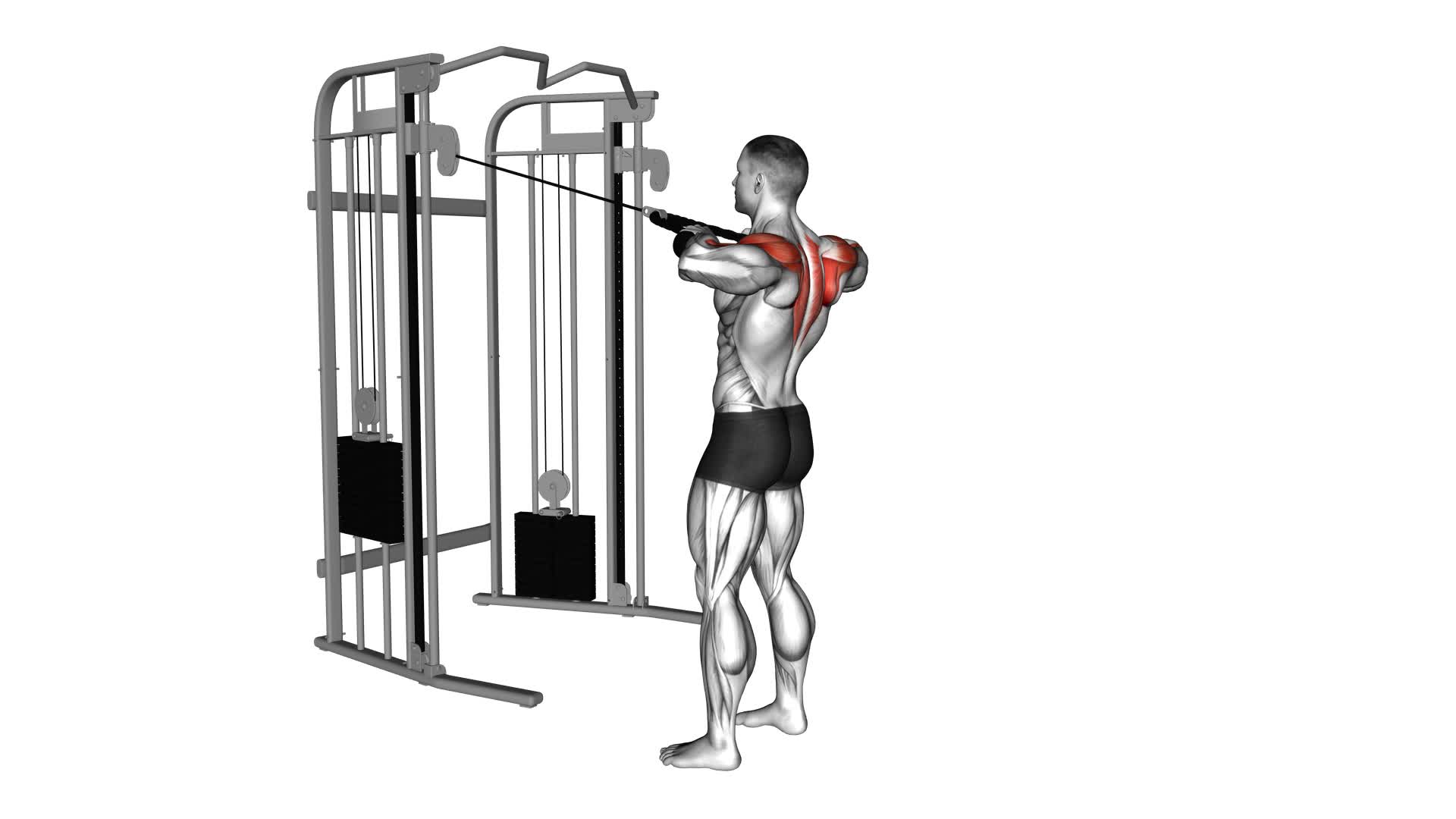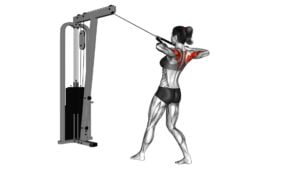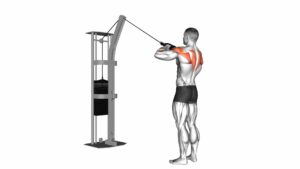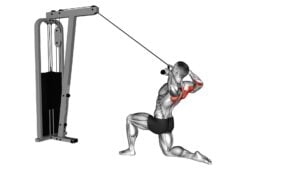Cable Standing Rear Delt Row (With Rope) – Video Exercise Guide & Tips

Are you looking for a new exercise to target your rear delts? Look no further than the cable standing rear delt row.
Watch This Exercise Video
This video exercise guide will show you the proper form and technique, along with variations for different fitness levels.
Avoid common mistakes and maximize the effectiveness of this exercise with helpful tips.
Get ready to strengthen and tone your rear delts like never before. Let's get started!
Key Takeaways
- The cable standing rear delt row targets multiple muscle groups simultaneously, including the rear deltoids, rhomboids, and trapezius.
- This exercise improves overall shoulder and upper back strength and stability.
- It is a versatile exercise that can be modified for different fitness levels.
- The cable standing rear delt row allows for a greater range of motion compared to other rear delt exercises.
Benefits of the Cable Standing Rear Delt Row
One major benefit of the Cable Standing Rear Delt Row is that it targets multiple muscle groups simultaneously. This exercise primarily works the rear deltoids, which are located at the back of your shoulders, but it also engages the upper back muscles, including the rhomboids and trapezius. By targeting these muscles together, you can improve your overall shoulder and upper back strength and stability.
Another benefit of the Cable Standing Rear Delt Row is its versatility. You can easily modify the exercise to suit your fitness level and goals. For beginners, starting with lighter weights and focusing on proper form is essential. As you become more comfortable and stronger, you can gradually increase the weight to make the exercise more challenging.
Additionally, the Cable Standing Rear Delt Row allows for a greater range of motion compared to other rear delt exercises. This increased range of motion helps to fully activate and engage the targeted muscles, leading to better results.
Equipment and Setup for the Exercise
To set up for the Cable Standing Rear Delt Row exercise, you'll need specific equipment and a proper setup. Here's what you'll need and how to set it up:
- Equipment:
- Cable machine: Ensure the cable machine is securely anchored and adjusted to the appropriate height.
- Rope attachment: Attach a rope handle to the cable machine.
- Bench or stability ball: Place a bench or stability ball in front of the cable machine to lean against during the exercise.
- Setup:
- Stand facing the cable machine with your feet shoulder-width apart.
- Grab the rope handle with an overhand grip, palms facing each other.
- Step back a few feet, keeping tension on the cable.
- Lean forward and brace your core.
- Maintain a slight bend in your knees and a straight back throughout the exercise.
- Engage your rear delts by squeezing your shoulder blades together as you pull the rope towards your body.
- Hold the contraction for a moment, then slowly release the rope back to the starting position.
Proper Form and Technique for the Cable Standing Rear Delt Row
Maintain a strong and stable stance as you perform the Cable Standing Rear Delt Row exercise. This exercise primarily targets the rear deltoids, the muscles located at the back of your shoulders. Proper form and technique are crucial to maximize the benefits and prevent injury.
To begin, attach a rope to the low pulley of a cable machine. Stand facing the machine with your feet shoulder-width apart. Grab the rope with an overhand grip, palms facing downward. Keep a slight bend in your knees and hinge forward at the hips, maintaining a neutral spine.
As you row, focus on squeezing your shoulder blades together and pulling the rope towards your body. Avoid using excessive momentum or jerking motions. Instead, maintain controlled movements throughout the exercise.
To modify the exercise, you can adjust the weight on the cable machine to suit your strength level. If you find it challenging to maintain balance, you can perform the exercise in a seated position on a bench.
Performing the Cable Standing Rear Delt Row with proper form and technique will help you develop stronger rear deltoids, improve posture, and enhance overall shoulder stability. Remember to engage your core and breathe steadily throughout the exercise for optimal results.
Variations and Modifications for Different Fitness Levels
Now let's explore some variations and modifications for different fitness levels when performing the Cable Standing Rear Delt Row.
If you're a beginner, there are beginner-friendly modifications available that can help you ease into the exercise and build strength gradually.
On the other hand, if you're more advanced and looking for an extra challenge, there are advanced intensity options that can be incorporated to push your limits.
Additionally, if you have limited mobility or specific physical restrictions, there are ways to adapt the exercise to suit your needs and still reap the benefits.
Beginner-Friendly Modifications
Are you looking for beginner-friendly modifications to the Cable Standing Rear Delt Row (With Rope) exercise? Here are some modification options that can help you ease into this exercise and build strength gradually:
- Lighten the weight: Start with a lighter weight on the cable machine to reduce the resistance and make the exercise more manageable for beginners.
- Adjust the grip: Instead of using the rope attachment, you can use a wider grip handle or even a single handle to target the rear deltoids while providing more stability.
- Reduce range of motion: Limit the range of motion by not pulling the cable all the way back. This modification can help beginners focus on proper form and avoid straining their muscles.
- Use a bench: If standing is too challenging, you can perform the exercise while seated on a bench. This modification provides additional support and stability.
Advanced Intensity Options
To ramp up the intensity and cater to different fitness levels, let's explore advanced variations and modifications for the Cable Standing Rear Delt Row (With Rope) exercise.
For those looking to take this exercise to the next level, adding resistance bands or increasing the weight on the cable machine can provide a greater challenge. These advanced modifications engage more muscle fibers, leading to increased strength and muscle development. However, it's vital to prioritize injury prevention when attempting advanced variations. Ensure proper form and technique, and listen to your body's limitations. If you feel any discomfort or pain, decrease the intensity or consult a fitness professional for guidance.
Now, let's transition into the next section, where we'll discuss adapting the exercise for those with limited mobility.
Adapting for Limited Mobility
To adapt the Cable Standing Rear Delt Row (With Rope) exercise for limited mobility, you can incorporate variations and modifications to accommodate different fitness levels. Here are some adaptations and exercises you can try:
- Variations for limited mobility:
- Seated Cable Rear Delt Row: Instead of standing, sit on a bench or chair and perform the exercise with a cable machine.
- Resistance Band Rear Delt Row: Use a resistance band instead of a cable machine to perform the exercise. This allows for more flexibility and can be done anywhere.
- Modifications for different fitness levels:
- Lighter Weights: If you're a beginner or have limited strength, start with lighter weights and gradually increase as you get stronger.
- Increased Range of Motion: To challenge yourself, try extending your arms fully and squeezing your shoulder blades together at the end of each repetition.
Common Mistakes to Avoid During the Exercise
One common mistake to avoid during the exercise is using too much weight. While it may be tempting to load up the cable machine with heavy plates, using excessive weight can compromise your form and lead to injury. The key to a successful cable standing rear delt row is to focus on the technique rather than the weight.
Another mistake to avoid is improper posture. It's important to maintain a neutral spine and engage your core throughout the exercise. Avoid rounding your back or hunching your shoulders, as this can put unnecessary strain on your spine and limit the effectiveness of the exercise.
Additionally, rushing through the repetitions is a common mistake. Take your time and ensure that you're performing each rep with proper form and control.
Lastly, avoid pulling with your biceps instead of using your rear deltoids. To maximize the effectiveness of the cable standing rear delt row, it's crucial to pull the ropes towards your chest using your shoulder muscles, specifically the rear delts.
Tips for Maximizing the Effectiveness of the Cable Standing Rear Delt Row
To maximize the effectiveness of the cable standing rear delt row, focus on maintaining proper form and engaging your shoulder muscles throughout the exercise. Here are some tips to help you maximize your results and ensure proper muscle activation:
- Use the appropriate weight: Choose a weight that challenges you, but still allows you to maintain proper form throughout the movement. Using too heavy of a weight can compromise your form and lead to ineffective muscle activation.
- Focus on squeezing your shoulder blades: As you pull the rope towards your body, focus on squeezing your shoulder blades together. This will help to activate your rear deltoids and ensure that you're targeting the correct muscles.
- Avoid using your biceps: It's important to remember that this exercise is primarily targeting the rear deltoids. To maximize the effectiveness of this exercise, avoid using your biceps to pull the weight towards you. Instead, focus on using your shoulder muscles to initiate and control the movement.
- Maintain a neutral spine: Keep your spine in a neutral position throughout the exercise. Avoid arching your back or hunching your shoulders. This will help to ensure proper muscle activation and prevent unnecessary strain on your spine.
Frequently Asked Questions
What Are Some Alternative Exercises That Target the Same Muscle Groups as the Cable Standing Rear Delt Row?
Looking for alternative exercises that target the same muscle groups as the cable standing rear delt row? There are a few options you can try.
One is the bent over dumbbell row, which works your rear delts, as well as your upper back and biceps.
Another option is the seated cable row, which also targets your rear delts, while engaging your lats and biceps.
Lastly, you can do the face pull exercise, which specifically targets your rear delts, helping to improve your overall shoulder strength.
How Often Should I Perform the Cable Standing Rear Delt Row to See Results?
To see results from the cable standing rear delt row, consistency is key. It's important to perform the exercise regularly, ideally 2-3 times a week.
However, the amount of time it takes to see results can vary depending on factors such as your fitness level and diet.
It's not necessarily required to use heavy weights to see results, as proper form and technique are more important.
Focus on gradually increasing the resistance over time to continue challenging your muscles.
Can I Perform the Cable Standing Rear Delt Row With a Resistance Band Instead of a Cable Machine?
Yes, you can perform the cable standing rear delt row with a resistance band instead of a cable machine.
Using a resistance band as an alternative offers several benefits. It allows for a wider range of motion, targets the muscles in a different way, and can be easily adjusted for different resistance levels.
Incorporating resistance bands into your workouts can help improve strength, stability, and overall muscle development.
Are There Any Specific Warm-Up Exercises I Should Do Before Starting the Cable Standing Rear Delt Row?
Before starting the cable standing rear delt row, it's important to do specific warm-up exercises to prepare your shoulder muscles. These warm-up exercises can help increase blood flow and mobility, reducing the risk of injury.
Some examples of warm-up exercises you can do include shoulder circles, arm swings, and band pull-aparts. By incorporating these warm-up exercises into your routine, you can ensure that your shoulder muscles are properly activated and ready for the cable standing rear delt row.
Can the Cable Standing Rear Delt Row Help Improve Posture?
The cable standing rear delt row can definitely help improve your posture. By targeting the rear deltoids, this exercise strengthens the muscles responsible for pulling your shoulder blades back and down, promoting a more upright position.
Good posture is essential for overall spinal health and can prevent issues like rounded shoulders and upper back pain. So, incorporating the cable standing rear delt row into your workout routine can have significant benefits for your posture.
Conclusion
In conclusion, the cable standing rear delt row is a highly effective exercise for targeting and strengthening the rear deltoid muscles. By using the proper equipment and maintaining correct form and technique, you can maximize the benefits of this exercise.
Additionally, there are variations and modifications available to accommodate different fitness levels. It's important to avoid common mistakes and follow the tips provided to ensure the exercise is performed safely and effectively.
Incorporating the cable standing rear delt row into your workout routine can greatly enhance your shoulder strength and posture.

Author
Years ago, the spark of my life’s passion ignited in my mind the moment I stepped into the local gym for the first time. The inaugural bead of perspiration, the initial endeavor, the very first surge of endorphins, and a sense of pride that washed over me post-workout marked the beginning of my deep-seated interest in strength sports, fitness, and sports nutrition. This very curiosity blossomed rapidly into a profound fascination, propelling me to earn a Master’s degree in Physical Education from the Academy of Physical Education in Krakow, followed by a Sports Manager diploma from the Jagiellonian University. My journey of growth led me to gain more specialized qualifications, such as being a certified personal trainer with a focus on sports dietetics, a lifeguard, and an instructor for wellness and corrective gymnastics. Theoretical knowledge paired seamlessly with practical experience, reinforcing my belief that the transformation of individuals under my guidance was also a reflection of my personal growth. This belief holds true even today. Each day, I strive to push the boundaries and explore new realms. These realms gently elevate me to greater heights. The unique combination of passion for my field and the continuous quest for growth fuels my drive to break new ground.







